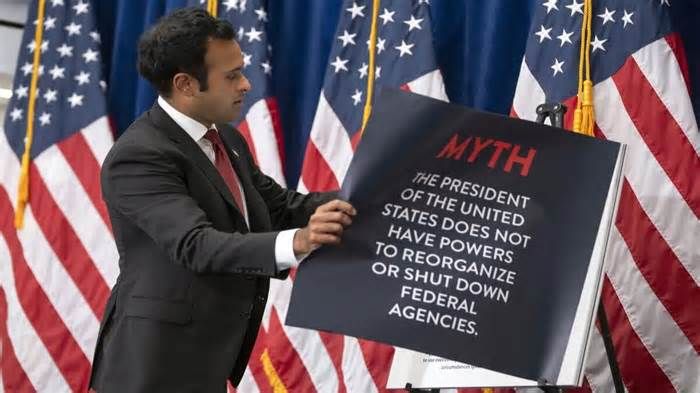Vivek Ramaswamy’s Controversial Plan to Reshape the US Federal Workforce

In a bold and contentious statement, Indian-American entrepreneur and Republican presidential candidate, Vivek Ramaswamy, has declared his intention to dramatically downsize the federal workforce by more than 75% if he is elected as the President of the United States. This provocative proposal also includes the disbandment of major federal agencies such as the Department of Education, the FBI, the Food and Nutrition Service, the Nuclear Regulatory Commission, and the Bureau of Alcohol, Tobacco, Firearms, and Explosives. With approximately 2.25 million people currently employed in civilian roles within the federal government, such a massive reduction would result in over 1.6 million individuals losing their jobs, potentially saving billions of dollars in the federal budget but also raising concerns about the disruption of essential government functions.
This audacious plan bears a striking resemblance to the policies of former President Donald Trump, whom Ramaswamy has lauded as the best President of the 21st century. During an interview with Axios, Ramaswamy emphasized his desire to cut the federal civil workforce by 75% within four years and achieve a 50% reduction by the end of his first year in office. He pointed out that nearly 30% of federal employees are eligible for retirement in the next five years, which he argues makes his proposal substantial but not as radical as it might initially seem.
Ramaswamy’s campaign website outlines his ambitious goals, which include “dismantling managerial bureaucracy” by closing down what he refers to as “toxic government agencies,” dismantling federal employee unions, relocating more than 75% of federal employees outside of Washington, D.C., and eliminating wasteful expenditures, according to The Hill.
In a manner reminiscent of Trump’s characterization of a “deep state” within the federal government, Ramaswamy has also taken a confrontational stance towards certain parts of the bureaucracy. He recently stated at the America First Policy Institute in Washington, D.C., “We will use executive authority to shut down the deep state.” While Ramaswamy named several agencies he intends to abolish, he also indicated that many of their functions would be transferred to other organizations, suggesting that many of the same jobs would still exist elsewhere.
Ramaswamy’s proposal to reduce the federal workforce by such a substantial margin has ignited a fierce debate, with proponents arguing that it could lead to significant cost savings and a more efficient government. Critics, on the other hand, express deep concerns about the potential consequences of such drastic measures.
Supporters of Ramaswamy’s plan argue that a leaner government could result in substantial savings for American taxpayers. By shedding 75% of the federal workforce, billions of dollars could potentially be redirected towards other priorities, such as reducing the national debt or investing in critical infrastructure projects. Proponents also contend that a smaller government could be more agile and responsive to the needs of the American people.
Additionally, Ramaswamy’s focus on relocating federal employees outside of the Washington, D.C. area could have the positive effect of decentralizing government operations and spreading economic opportunities to regions that are often overlooked. This approach might lead to a more equitable distribution of government resources and a reduction in the concentration of political power in the nation’s capital.
Critics, however, raise several important concerns about the potential consequences of such a drastic downsizing of the federal workforce. One of the most pressing issues is the impact on essential government functions. Disbanding agencies like the FBI, which plays a crucial role in national security and law enforcement, could create significant vulnerabilities and hamper the government’s ability to protect its citizens.
Moreover, the abrupt termination of over 1.6 million jobs could have a cascading effect on the economy, leading to widespread unemployment and economic instability. Critics argue that the resulting financial strain on individuals and families could exacerbate social and economic inequalities and strain public resources, such as welfare and unemployment benefits.
The question of whether many of these federal jobs would still exist, albeit in different organizations, also remains unanswered. While Ramaswamy suggests that some functions would be transferred elsewhere, it remains to be seen how efficiently this transition would be executed and whether it would result in cost savings or merely a reshuffling of government employees.
News Mania Desk / Agnibeena Ghosh 18th September 2023






